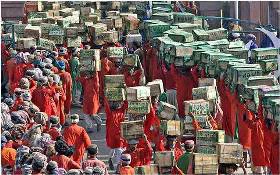
According to the World Bank’s Doing Business report, it takes 32 days on average to complete trade-related procedures in South Asia, among the highest in the world. Nearly 70% of the time is spent on assembling and processing an odious number of documents.
Given the bottlenecks, it comes as no surprise that South Asia is the least integrated region in the world. In fact, it accounts for just 2% percent of world trade and 1.7% of world foreign direct investment, according to the Asian Development Bank. Intraregional trade constitutes just 6% percent of its total trade.
Policymakers are quick to blame trade barriers such as tariffs, quotas, or technical requirements. But untangling the knot of trade politics has been difficult. The long-stalled Doha Round of trade talks recently prompted WTO director Pascal Lamy to ask leaders to think hard about "the consequences of throwing away 10 years of solid multilateral work." Even the South Asian Free Trade Agreement (SAFTA) implemented in 2006 failed to produce substantial results for the region.
Given the short supply of optimism, some fresh thinking is needed. Last week, a new report, "Enabling Trade: Valuing Growth Opportunities," found that supply chain barriers are more detrimental to world trade than tariffs. In fact, reducing supply chain barriers could increase world GDP over six times more than removing all tariffs.
If every country improved just two key supply chain barriers – border administration and transport and communications infrastructure – even halfway to the world’s best practices, global GDP could increase by $2.6 trillion (4.7%) and exports by $1.6 trillion (14.5%). In contrast, doing away with tariffs would increase global GDP by $0.4 trillion (0.7%) and exports by $1.1 trillion (10.1%). The gains in South Asia would be even sharper. Improving trade facilitation systems to international standards could potentially see intraregional trade rise by 60%.
Why is lowering barriers so effective? According to trade theory, abolishing tariffs merely reallocates resources, but lowering trade barriers reduces waste. In addition, the gains from reducing barriers are more evenly distributed among nations than the gains from eliminating tariffs.
Theory aside, modern trade is more than just buying and selling across borders. Production involves goods crossing many borders, accruing components in diverse settings before ending up in a retail store. This sophisticated process needs alignment on all aspects that affect the costs and reliability of the supply chain – from customs administration to transport infrastructure.
A new database developed by the United Nations Economic and Social Commission for Asia and the Pacific and the World Bank found that trade costs fall disproportionally on developing countries. Granted that reducing supply chain barriers require investment, while tariff reductions require only the stroke of a pen, many barriers can be traced to regulation. Given the dismal state of global tariff discussions, managing supply chain costs may give us the most policy bang for the buck.


Join the Conversation